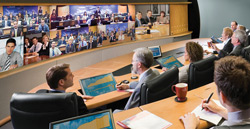
No doubt you have heard or used the phrase “a picture is worth a thousand words.” More than likely, you have also experienced the reality that 55 percent of communication is determined by nonverbal cues—namely, tone of voice and body language. Noticeably absent from email and written forms of communication, these elements give us critical clues to the true meaning of what the other person is communicating. The power and significance of personal, face-to-face communication is undebatable. As important as it is, though, it is at times simply impossible in today’s business environment.
The proposition of telepresence is to technologically produce the feeling of being present at a location other than where we are physically. Video conferencing is a simple, yet powerful example. Applications for video conferencing abound across a broad spectrum, from a simple, two-party, PC-based conversation using a webcam and your laptop to a remote classroom presentation to a multi-site, multimedia interactive collaboration. Each has a specific set of challenges and benefits, but each shares the common goal of facilitating face-to-face communication.
Some commonly reported benefits from businesses using video conferencing are:
- Reduced travel time, stress and expense
- More efficient allocation of resources
- Accelerated decision making
- Increased productivity across dispersed workforces
- More accurate conveyance of information and ideas.
How many times have you picked up the telephone and called someone to confirm or clarify a series of email messages? Or sent document attachments with the email to illustrate an idea or product? Did the attachments make it past the firewall? Then, do you follow up these initial communications with “We need to get together and go over this in detail?” The power of video conferencing will dramatically streamline this process.
 Alternatively, imagine that you place a video conference call with the same ease and convenience as a telephone call. During the conference, you present a video clip of a new marketing idea and chart a proposed schedule and cost table from your desktop. From their smiles, you know your idea was received well. After making changes to the schedule from their desktop, the campaign receives approval with a nod.
Alternatively, imagine that you place a video conference call with the same ease and convenience as a telephone call. During the conference, you present a video clip of a new marketing idea and chart a proposed schedule and cost table from your desktop. From their smiles, you know your idea was received well. After making changes to the schedule from their desktop, the campaign receives approval with a nod.
This illustrates a potential real-life application of using video conference technology to improve the way we communicate in business. The two people in the example could have just as easily been a group of 10, 20 or more. They might have been in different areas of the same building, across town or around the globe. Locale does not dictate presence. Video conferencing overcomes physical boundaries to personal interaction.
Technological evolution since the inception of video conferencing in the mid-seventies has dramatically broadened the quality and variety of affordable solutions available to businesses of all types. Virtually any work flow process that involves telephone, email or travel can be improved with the application of video conferencing. The first step is to imagine how your organization might use video. Then you will be ready to discuss your vision with a qualified vendor to evaluate and assess solutions. Once video conferencing is implemented, you will likely discover additional, unimagined applications that will positively transform the way your business communicates. It truly is the next best thing to being there. iBi

